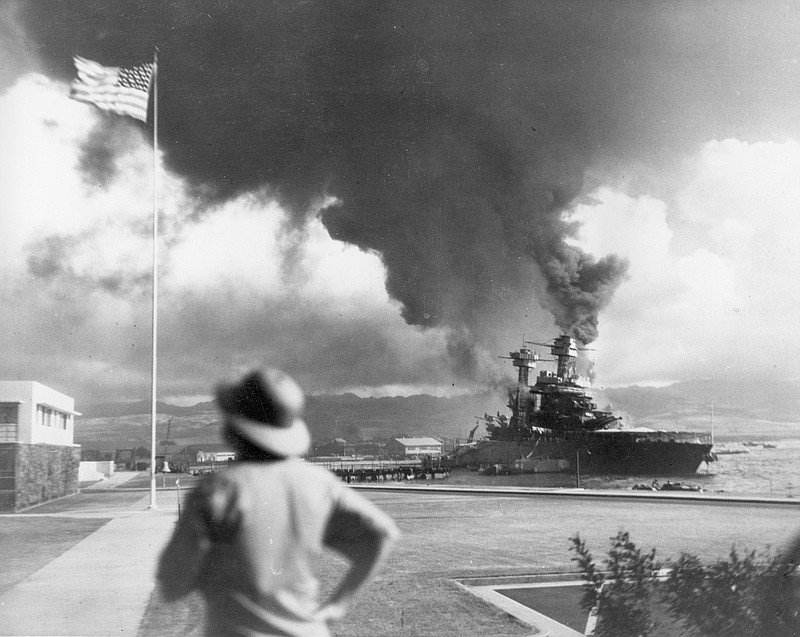FOUKE, Ark. -- About Dec. 1, 1941, relatives of area resident Hubert Aaron mailed him a Christmas package that came back marked "undeliverable" -- and his family already knew why.
The package returned about Dec. 20, just as Aaron's family received a telegram from the Navy with the heart-breaking words, "Deeply regret to inform you that your son, Hubert Aaron, is missing following action in the service of his country."
Aaron, 22, was among the more than 2,400 servicemen killed in the Dec. 7, 1941, Japanese attack on Pearl Harbor. He was aboard the battleship USS Arizona.
On Memorial Day 2021, Aaron's life and death became the subject of a 121-page book written by Frank McFerrin, curator of the Miller County Historical and Family Museum.
"The Story of Hubert Aaron" is about "a young man, the families that produced him, the sacrifice he made and what it meant as he died Dec. 7, 1941 on board the U.S.S. Arizona," McFerrin wrote in the introduction to his book.
The book is McFerrin's latest in a two-book series paying tribute to the so-called Greatest Generation of World War II. The previous work was on Fouke resident James "Jack" Smith, who served as a radio operator and machine gunner aboard a B-24 Liberator bomber in Europe.
Of the more than 16 million U.S. servicemen and women who went into the armed services during the war, there are about 240,000 still living.
Aaron began his military training in the vessel's engine room and eventually received the rank of fireman second class. The assignment involved training to inspect bearings, oiling of the engines and running fire pumps, according to page 89 in McFerrin's book.
"Most of these men who volunteered had never seen the ocean nor even a Navy boat," McFerrin wrote. "They were paid $21 a month, which was more than most of them could make during the Great Depression."
Aaron eventually received about $34 a month once he achieved more proficiency as fireman second class.
McFerrin, who started working on Aaron's story in late summer 2020 before publishing on Memorial Day 2021, starts the narrative with Aaron's birth on Oct. 29, 1919, in the Garland township, also known as the Shiloh community at the time.
Born to Alfred Alonzo and Jennie Aaron, Hubert Aaron grew up the youngest of six siblings living in the Ferguson and Sylverino communities northwest of Fouke.
Aaron attended Fouke High School from 1935 to 1937 but apparently dropped out and did not graduate, according to McFerrin's account. Aaron seems to have gone to work at a lumber business, saw mill and cotton gin before enlisting in Oct. 14, 1940, according to McFerrin's book.
After eight weeks of basic training in San Diego, Aaron requested and was granted an assignment to the 35,000-ton Arizona, which was docked at Bremerton, Washington, in early January 1941. The battleship, which cost $16 million to build, was completed in June 1915. It reportedly could hold up to 1.5 million gallons of fuel oil and carry a crew of about 1,700 sailors.
On Jan. 19, 1941, the Arizona sailed along the California coast to San Pedro near Long Beach, not too far from Los Angeles, before eventually heading to Hawaii for fleet exercises. It sailed into Pearl Harbor on Feb. 3, according to McFerrin's book.
Once arriving in Pearl Harbor, the Arizona remained stationed there for 11 months, participating in training exercises on the open sea. From there, it received posting both in and out of Pearl Harbor.
By the end of 1941, the plan was to have the Arizona steam back to Washington state about 10 days before Christmas for Aaron and other sailors to have holiday leave.
However, those plans changed on Dec. 7.
Shortly after the Japanese attack, it didn't take Navy officials long to find out that the Arizona was the most seriously hit of the eight battleships in the harbor. Of the more than 2,400 American deaths caused by the attack, nearly half of them were aboard the Arizona.
"It was a cool, crisp and clear Sunday" in the Texarkana, Arkansas area, where Aaron's parents lived, when troubling news came on the car radio about 1:25 p.m. that the Japanese had attacked Pearl Harbor, McFerrin writes. Aaron's mother, Jennie, began screaming, "No! No! No!"
Alonzo Aaron tried to comfort his wife by saying their son could still be alive. A Dec. 20 Navy telegram listing Hubert as only "missing in action" may have given his parents a glimmer of hope. Any optimism, however, faded in a Jan. 23, 1942, letter from Secretary of the Navy Frank Knox.
"I desire to offer you my personal condolence in the tragic death of your son, Hubert Aaron ... which occurred at the time of the attack by the Japanese December Seventh. It is hoped that you may find comfort in the thought that he made the supreme sacrifice upholding the highest traditions of the Navy, in the defense of his country."
Through his research of Aaron's family, McFerrin learned they had been "faithful Christians, reading the Word and attending regular worship services."
"Jennie Aaron called upon the 'Rock of Ages' -- as a source of power that she knew was greater than she. How else could she face such a terrible time in her life," McFerrin wrote near the end of the book.
Copies of McFerrin's book are available at the Miller County Historical and Family Museum.

